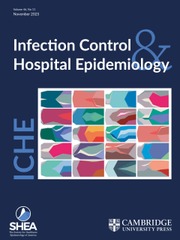Crossref Citations
This article has been cited by the following publications. This list is generated based on data provided by
Crossref.
Baron, Ellen Jo
1992.
The detection, significance, and rationale for control of methicillin-resistant Staphylococcus aureus.
Clinical Microbiology Newsletter,
Vol. 14,
Issue. 17,
p.
129.
Boyce, John M.
1992.
Methicillin-Resistant Staphylococcus aureus in Hospitals and Long-Term Care Facilities: Microbiology, Epidemiology, and Preventive Measures.
Infection Control and Hospital Epidemiology,
Vol. 13,
Issue. 12,
p.
725.
Mulligan, Maury Ellis
Murray-Leisure, Katherine A.
Ribner, Bruce S.
Standiford, Harold C.
John, Joseph F.
Korvick, Joyce A.
Kauffman, Carol A.
and
Yu, Victor L.
1993.
Methicillin-resistant Staphylococcus aureus: A consensus review of the microbiology, pathogenesis, and epidemiology with implications for prevention and management.
The American Journal of Medicine,
Vol. 94,
Issue. 3,
p.
313.
Boyce, John M.
Jackson, Marguerite M.
Pugliese, Gina
Batt, Murray D.
Fleming, David
Garner, Julia S.
Hartstein, Alan I.
Kauffman, Carol A.
Simmons, Mildred
Weinstein, Robert
and
Williams, Carol O'Boyle
1994.
Methicillin-Resistant Staphylococcus aureus (MRSA): A Briefing for Acute Care Hospitals and Nursing Facilities.
Infection Control & Hospital Epidemiology,
Vol. 15,
Issue. 2,
p.
105.
Struelens, Marc J.
Ronveaux, Olivier
Jans, Béatrice
and
Mertens, Raf
1996.
Methicillin-Resistant Staphylococcus aureus Epidemiology and Control in Belgian Hospitals, 1991 to 1995.
Infection Control & Hospital Epidemiology,
Vol. 17,
Issue. 8,
p.
503.
Struelens, Marc J.
Ronveaux, Olivier
Jans, Béatrice
and
Mertens, Raf
1996.
Methicillin-ResistantStaphylococcus aureusEpidemiology and Control in Belgian Hospitals, 1991 to 1995.
Infection Control & Hospital Epidemiology,
Vol. 17,
Issue. 8,
p.
503.
Ramotar, Karam
Bobrowska, Maria
Jessamine, Peter
and
Toye, Baldwin
1998.
Detection of Methicillin Resistance in Coagulase-Negative Staphylococci Initially Reported as Methicillin Susceptible Using Automated Methods.
Diagnostic Microbiology and Infectious Disease,
Vol. 30,
Issue. 4,
p.
267.
Hamze, M
Dabboussi, F
Daher, W
and
Izard, D
2003.
Résistance aux antibiotiques de Staphylococcus aureus au Nord du Liban : place de la résistance à la méticilline et comparaison des méthodes de détection.
Pathologie Biologie,
Vol. 51,
Issue. 1,
p.
21.
Joyce, Maria
and
Woods, Christopher W
2004.
Antibacterial susceptibility testing in the clinical laboratory.
Infectious Disease Clinics of North America,
Vol. 18,
Issue. 3,
p.
401.
Nour, Mohamed
Mastouri, Maha
and
Ben Nejma, Mouna
2005.
Le staphylocoque doré résistant à la méticilline : émergence et bases moléculaires de la résistance.
Pathologie Biologie,
Vol. 53,
Issue. 6,
p.
334.
Prère, M.F.
Baron, O.
Cohen Bacrie, S.
and
Fayet, O.
2006.
Genotype MRSA, a new genetic test for the rapid identification of staphylococci and detection of mecA gene.
Pathologie Biologie,
Vol. 54,
Issue. 8-9,
p.
502.
Mastouri, M.
Nour, M.
Ben Nejma, M.
Bouallegue, O.
Hammami, M.
and
Khedher, M.
2006.
Résistance aux antibiotiques de Staphylococcus aureus résistant à la méticilline : détection des premières souches de sensibilité diminuée aux glycopeptides en Tunisie.
Pathologie Biologie,
Vol. 54,
Issue. 1,
p.
33.
Orscheln, Rachel C.
Shinefield, Henry R.
and
St. Geme, Joseph W.
2006.
Infectious Diseases of the Fetus and Newborn Infant.
p.
513.
Tawil, Nancy
Mouawad, Flaviana
Lévesque, Simon
Sacher, Edward
Mandeville, Rosemonde
and
Meunier, Michel
2013.
The differential detection of methicillin-resistant, methicillin-susceptible and borderline oxacillin-resistant Staphylococcus aureus by surface plasmon resonance.
Biosensors and Bioelectronics,
Vol. 49,
Issue. ,
p.
334.
Giulieri, Stefano G.
Guérillot, Romain
Kwong, Jason C.
Monk, Ian R.
Hayes, Ashleigh S.
Daniel, Diane
Baines, Sarah
Sherry, Norelle L.
Holmes, Natasha E.
Ward, Peter
Gao, Wei
Seemann, Torsten
Stinear, Timothy P.
Howden, Benjamin P.
and
Pettigrew, Melinda M.
2020.
Comprehensive Genomic Investigation of Adaptive Mutations Driving the Low-Level Oxacillin Resistance Phenotype in Staphylococcus aureus.
mBio,
Vol. 11,
Issue. 6,
Zhu, Meng
Wang, Zhao-Jie
He, Ying-Jie
Qin, Yan
Zhou, Ying
Qi, Zi-Heng
Zhou, Zhong-Shun
Zhu, Yan-Yan
Jin, Dan-Ni
Chen, Shan-Shan
and
Luo, Xiao-Dong
2021.
Bioguided isolation, identification and bioactivity evaluation of anti-MRSA constituents from Morus alba Linn..
Journal of Ethnopharmacology,
Vol. 281,
Issue. ,
p.
114542.
Mlynarczyk-Bonikowska, Beata
Kowalewski, Cezary
Krolak-Ulinska, Aneta
and
Marusza, Wojciech
2022.
Molecular Mechanisms of Drug Resistance in Staphylococcus aureus.
International Journal of Molecular Sciences,
Vol. 23,
Issue. 15,
p.
8088.
Kaplan, Sheldon L.
and
Hulten, Kristina G.
2025.
Feigin and Cherry's Textbook of Pediatric Infectious Diseases.
p.
798.
Meng, Xin
Kang, Mengna
Yu, Zhiyun
Li, Changyou
Chen, Yang
Jin, Taicheng
Wang, Kai
and
Guo, Haiyong
2025.
Synergistic antibacterial activity of baicalin in combination with oxacillin sodium against methicillin‐resistant Staphylococcus aureus.
FEBS Open Bio,
Vol. 15,
Issue. 4,
p.
608.
Ma, Shiwei
Xu, Yufan
Ma, Juanjuan
Luo, Dan
Huang, Zixin
Wang, Longlong
Xie, Weile
Luo, Zhen
Zhang, Huanhuan
Jiang, Jijie
Jin, Yaozhong
Zhang, Jianming
Zhu, Jianguo
and
Wang, Zhe
2025.
Mechanisms of Staphylococcus aureus Antibiotics Resistance Revealed by Adaptive Laboratory Evolution.
Current Microbiology,
Vol. 82,
Issue. 1,

